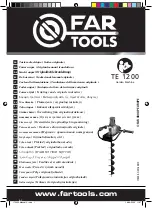
Matrize
PN 539682-2
411-18100 / Rev. D1
Die Set
PN 539682-2
411-18100 / Rev. D1
Seite /
Page
6 of 11
Bild / Figure 3
Abisolierlänge
Strip lenght
Kontakt (typ.)
Contact (Typ)
Zangenvorderseite
Front of Tool
Zangenrückseite
Back of Tool
3. Position the contact so that the mating end of the
contact is on the Locator side of the tool, and that
the open "U" of the wire barrels face the top of the
tool.
CAUTION
Make sure that both crimpflanks of the wire
barrel are started evenly into the crimping
section. Do NOT attempt to crimp an
improperly positioned contact.
4. Hold the contact in position and squeeze the tool
handles together until ratchet engages sufficiently
to hold the contact in position. Do NOT deform
insulation barrel or wire barrel.
5. Insert stripped wire into contact wire barrel
(Figure 3).
6. Holding the wire in place, squeeze tool handles
together until ratchet releases. Allow tool handles
to open and remove crimped contact.
7. Check the contacts crimp height as described in
Section 5, CRIMP HEIGHT INSPECTION. If
necessary, adjust the crimp height as described
in Section 6, CRIMP HEIGHT ADJUSTMENT.
3. Positionieren Sie den Kontakt so, daß sich der
Kontaktierbereich des Kontaktes auf der Seite
des Kontaktpositionierers befindet und die Crimp-
flanken (U-Form) des Draht- und Drahtcrimps
nach oben gerichtet sind.
VORSICHT
Stellen Sie sicher, daß die beiden Crimp-
flanken des Drahtcrimps im Crimpbereich
gleichmäßig geführt werden. Versuchen Sie
NICHT, einen ungenau positionierten Kontakt
zu crimpen.
4. Halten Sie den Kontakt in Position und drücken
Sie die Zangengriffe soweit zusammen, bis der
Ratschenmechanismus entsprechend verriegelt
und der Kontakt in der Zange gehalten wird.
Achten Sie darauf, daß Sie die Isolations- und
Drahtcrimpflanken NICHT deformieren.
5. Führen Sie die abisolierte Leitung in die
Drahtcrimphülse (Bild 3).
6. Halten Sie die Leitung in dieser Stellung und
drücken Sie die Zangengriffe zusammen, bis der
Ratschenmechanismus auslöst bzw. öffnet. Las-
sen Sie die Zange vollständig öffnen und entneh-
men Sie den gecrimpten Kontakt.
7. Überprüfen Sie die Crimphöhe, wie nachstehend
beschrieben. Nehmen Sie ggf. eine Einstellung
der Crimphöhe vor.





























